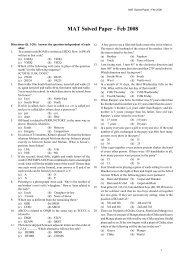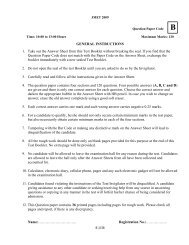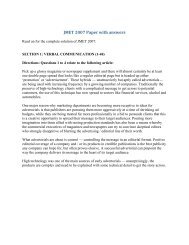ADMISSION TEST FOR PROGRAMME 2008-10
ADMISSION TEST FOR PROGRAMME 2008-10
ADMISSION TEST FOR PROGRAMME 2008-10
Create successful ePaper yourself
Turn your PDF publications into a flip-book with our unique Google optimized e-Paper software.
Passage 2<br />
Around the turn of the century; an interesting trend was slowly becoming<br />
prominent in retailing across the globe. Department stores were slowly becoming less<br />
and less popular with customers. Large department stores offered a wide range of<br />
product categories - from apparel, luggage, toys, crockery, to home furnishing - as well<br />
as owned and managed the stock of products they sold inside the store and from their<br />
warehouses. Industry analysts started questioning whether this could still be the ideal<br />
retail model, and whether the changing retail environment marked the end of large<br />
department stores as we knew them.<br />
On one side there were the stores that focussed on a particular category -<br />
electronics, toys, women's wear or home appliances. Over the years, these had evolved<br />
into giant superstores and had become very popular with customers who went shopping<br />
for a particular product. On the other hand, there were discounters, hypermarkets and<br />
wholesale clubs that served the bargain-hunting customer very well. Department stores<br />
were squeezed in between and the new age shoppers found their ambience to be formal<br />
and boring.<br />
To keep pace with these trends, some department stores were steadily reinventing<br />
themselves. The most prominent among them was UK based Selfridges chain. In 2003,<br />
Selfridges launched a new store in Birmingham, England that completely reinvented the<br />
idea of the department store. Brands competed with each other within the store but there<br />
was no heirarchy of goods: watches competed with perfume, and luggage with fashion. In<br />
addition the store organised various shows, stunts and performances through out the day<br />
and called it, ‘shopping entertainment.’ Similar stores had come up in various parts of<br />
Southeast Asia, Japan and Europe. For customers, these new-age department stores<br />
seemed like a mall, just that they didn't have the walls that separate the different stores<br />
within a mall.<br />
While this trend was becoming more and more apparent abroad, within India too,<br />
certain consumer patterns were emerging. Our experience showed that a customer<br />
visiting a mall typically walks into four or five stores. That includes a large store and a<br />
few smaller brand showrooms. After that fatigue sets in and he or she is unwilling to<br />
walk into any more stores at the mall. So we asked ourselves, what would happen if we<br />
removed the walls between the different stores in a mall? In that case, a customer would<br />
be exposed to multiple brands at the same time, without the necessity of walking in and<br />
out of different stores. And along with shopping we could also provide her with other<br />
entertainment options.<br />
Within the company itself there was a renewed confidence and an urge to play a<br />
larger role in shaping the modern retailing space in India. We had completed more than<br />
six years in retailing. With Big Bazaar we had tried and tested our skills at offering a<br />
wide range of categories while Pantaloons was firmly positioned in the lifestyle segment.<br />
We could now create shopping and entertainment landmarks in the cities in which we had<br />
already established a strong presence.<br />
33

















